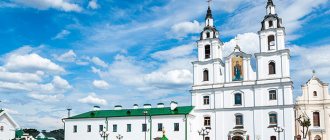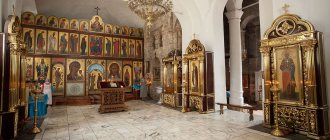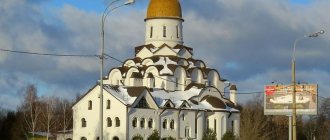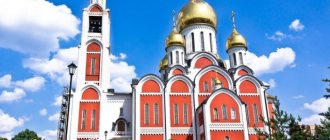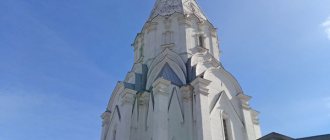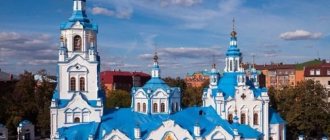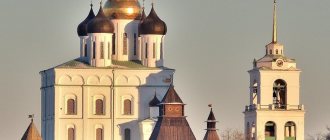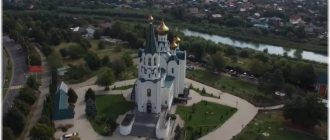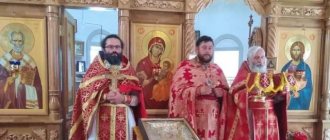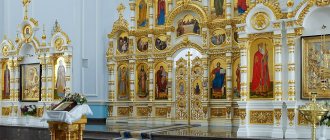The Temple of the Descent of the Holy Spirit (the second name is the Church of the Descent) is one of the oldest in Kazan. It was built in the 1730s and became the largest in the city at that time, accommodating about 4,000 people.
The temple is located in the Sukonnaya Sloboda area, and it is one of the few buildings from the 18th century that has survived in this area. The temple has two altars: the main chapel is consecrated in honor of the Descent of the Holy Spirit on the Apostles, and the left one is in honor of the Hieromartyr Harlampius, the patron saint of the Cloth Settlement.
The church was built in the provincial baroque style. Currently, the temple is recognized as an architectural monument of republican significance. It also has great historical significance: in the church choir at the temple in 1882, nine-year-old Fyodor Chaliapin, the famous Russian opera and chamber singer, was a singer. During its existence, the temple has undergone many changes and transformations: it was completed, closed and partially destroyed. It became available to parishioners again in 2015.
This is a very beautiful, well-kept and cozy temple, in which an atmosphere of calm and tranquility reigns. The excellent acoustics still delight visitors today. The area around the temple is landscaped; its bells ring melodiously every hour during the day. Within the framework of the temple complex there is a parish folklore and ethnographic studio “Spirits of Day”. You can see and enter the Church of the Holy Spirit while walking along Peterburgskaya Street.
Interior decoration, © Official website of the church
Schedule of services at the Church of the Descent of the Holy Spirit
The temple operates according to the following schedule:
- from Monday to Saturday - from 7:00 to 19:00;
- on Sunday - from 6:00 to 19:00.
Morning services in the temple are held at 8:00 from Monday to Saturday; at 6:00 and 8:40 - on Sunday. Evening services and all-night vigils are held at 17:00.
The temple tries to keep up with the times and has its own accounts and channels on many social networks. This helps ministers and parishioners be closer. If you can’t visit the temple, you can order the services by submitting a note using the temple’s website; they will print it out and pray for you and your loved ones at the next service. Also on the site you can ask questions to clergy about Orthodoxy, about the church, about the Orthodox gymnasium at the temple.
You can get additional information on services and events that take place in the temple by calling or emailing the temple.
© s42
Story
The history of the temple dates back to 1633-1642 - the time when the church at the Bernardine monastery was built here. In 1741, it was severely destroyed by fire, which is why large-scale reconstruction was carried out.
In 1852, the novices of the monastery moved to Nesvizh, and in 1860 the Catholic church was reconsecrated into an Orthodox church. 10 years later, a men's monastery of the Holy Spirit was organized under her, in which monks from the Holy Trinity Monastery of Slutsk settled. They lived there until 1918, and in general the monastery existed until 1922.
Soon after the revolution, the cathedral was closed. It did not receive parishioners until the Great Patriotic War, when the German administration allowed religious services to be held here. After liberation from the Nazis, the Soviet authorities decided to convert the Peter and Paul Cathedral, the main Orthodox church in Minsk at that time, into an archive. As a result of such upheavals, the Cathedral of the Holy Spirit became a cathedral.
Church history
In 1731, by order of the widow of the owner of the cloth manufactory, E. I. Mikhlyaeva, construction began on a church in Sukonnaya Sloboda, and on August 2, 1735, it was consecrated in honor of the Descent of the Holy Spirit on the Apostles and the martyr Harlampy.
In 1802, the temple acquired a brick fence. In the middle of the 19th century, the cloth factory closed, and the Church of the Holy Spirit moved from the category of a factory to a city church facing the street.
In 1895, in memory of Emperor Alexander III (who died a year earlier), a five-domed chapel in the Russian-Byzantine style was built on the southeastern side of the temple. In 1897, a reconstruction was carried out inside the church in order to increase its capacity: for this purpose, most of the partitions and columns in the main halls of the temple were removed.
A remarkable fact in the history of the Spiritual Church is that it never burned. Parishioners saved it from ruin and burning during the popular uprising of Emelyan Pugachev in 1774. Pugachev himself, having already been captured, was kept under arrest for some time in the basement of the temple.
After the establishment of Soviet power, in 1931, the Church of the Descent of the Holy Spirit was closed, and its building was given over to a club. Since the 1950s, the temple housed the Kazan puppet theater. During this difficult period for all churches, the appearance and interior decoration were greatly damaged: the chapel and bell tower, the dome of the temple were destroyed, ancient icons and valuable utensils were lost.
© Tatyana Kvichanskaya
Spiritual Church of the Holy Trinity Sergius Lavra
Having examined in detail the external architectural decoration of the Moscow Kremlin cathedrals and become acquainted with many architectural details that I had previously paid little attention to, I began to pay attention to other churches and compare them with the Kremlin ones. On a working trip to the Trinity-Sergius Lavra, I looked at the church in honor of the Descent of the Holy Spirit to the Apostles with completely different eyes. It even seemed to me that it was very similar to the Temple of the Deposition of the Robe in the Moscow Kremlin. For the purity of the experiment, I will provide photographs of the temples from the eastern side (It is extremely inconvenient to photograph the Church of the Deposition of the Robe, it is “sandwiched” by neighboring buildings). Compare:
Church of the Deposition of the Robe in the Moscow Kremlin
Spiritual Church of the Trinity-Sergius Lavra.
Are they really similar? Before comparing both churches and looking at the details, let me remind you that the Spiritual Church was built in 1477. Its creators were Pskov masters. The same ones who were invited to Moscow by Grand Duke Ivan III to rebuild the architectural ensemble of the Kremlin. The model for the construction of the Spiritual Church was not Moscow churches, but the ancient monastery Trinity Cathedral. But one cannot help but notice the similarity of three churches - the Moscow Annunciation Cathedral, the Church of the Deposition of the Robe and the Spiritual Church of the Lavra. However, noticeable differences are visible in the appearance of the Deposition of the Robe and the Dukhovskaya churches, especially on the eastern side. 1. The Spiritual Church is special. There is a small belfry under the dome of the church. This type of temple is called “like the bells.” 2.The shape of the head of the temples is different. The Church of the Deposition of the Robe has a helmet-shaped dome, while the Dukhovskaya Church has a bulbous dome. On the dome of the Church of the Deposition of the Robe there are rows of “runner” (“runner”) and “curb”. There are none at the Spiritual Church.
Onion head of the Spiritual Church
Helmet-shaped dome of the Church of the Deposition of Robes.
The under-dome part of the drum of the Spiritual Church is decorated with the same ornaments as the walls of the temple.
Temple apse ornament
And here are the famous Pskov “runner” and “curb” on the Deposition of the Robe Church.
3. The apses of the Deposition of the Robe Church are low, while those of the Dukhovskaya Church are high, reaching almost to the zakomar.
Altar apses of the Spiritual Church.
Altar apses of the Church of the Deposition of the Robe
4.The design of the decorative belt on the eastern walls is different.
Altar apses of the Spiritual Church.
Church of the Deposition of the Robe
5. Along the entire perimeter of the lower part of the walls of the Spiritual Church there is a belt of clover-shaped ornament.
Belt of clover-shaped ornament
An architecture connoisseur will undoubtedly name several other differences in the eastern walls of the temples. We will see other differences a little later, let’s dwell on the similarities of the two temples. 1. Both churches have four pillars and three apses. Their sizes are approximately the same. 2. Zakomars have a keel shape.
Keel-shaped zakomars of the Spiritual Church
Keel-shaped zakomars of the Church of the Deposition of the Robe
Now pay attention to the belt of niches with balusters. I provide two photographs and do not name the temples.
I showed fragments of two different temples! The upper one is a fragment of the Spiritual Church, the lower one is of the Robbery Church.
And here's another mystery. Look at the two portals.
South portal of the Spiritual Church
Portal of the Church of the Deposition of Robe
They are very similar in shape - keel-shaped, perspective portals on both temples. ( The perspective portal was already known in Romanesque architecture. This is an expressively designed entrance to a building. It is decorated with tapering ledges, like steps. The rows of ledges are covered with rows of decreasing arches). But the difference in details is also very noticeable. On the Church of the Deposition of the Robe (top photo), the capitals of the columns are made in the form of tied sheaves. On the southern portal of the Spiritual Church, the capitals are multi-layered and have a regular classical shape. But on the Western portal they are different, much simpler. And the columns were intercepted by the Moscow “bead”.
Western portal of the Spiritual Church.
Perspective portal of the Assumption Cathedral of the Moscow Kremlin. Colored “beads” on the columns are in the lower part.
Another difference between the Dukhovskaya and the Robbery churches is the vertical blades of the walls. On the Spiritual Church they are convex, stepped, well defined, with capitals, emphasized by an additional semi-column on each blade.
Spiritual Church. Fragment
The blades on the walls of the Church of the Deposition of the Robe are simple, flat, wide, without any decorations.
Church of the Deposition of the Robe. Fragment
I also paid attention to the base of the central drum. On the Church of the Deposition of the Robe, the pedestal of the drum is low and faceted.
At the Spiritual Church, the base of the drum is decorated with high kokoshniks.
So what did we see more when comparing the two temples - similarities or differences? They were built at the same time. Both churches are attributed to Pskov masters. But even if they were built by the same architects, they in no case copied their works. They created something new, unique, inimitable.
Spiritual Church
In conclusion, I will add one more photo of the eastern wall of the Spiritual Church. Do you see the stairs? At first I thought it was a restoration.
The staircase is visible on the right.
But then I realized that it was intended for bell ringers. After all, initially there was no special passage to the church bell tower. The bell ringers stood on the ground, and long ropes were tied to the bells, which the monks pulled, swinging the bell tongues. Over time, the ringing strategy has changed and now the monks climb the bell tower using a ladder. I had a chance to listen to the ringing of the bells of the Spiritual Church on Easter week. I watched the bell ringer from Cathedral Square. During the ringing, the entire figure of the monk moved; it was clear that he was wielding several bells, and his legs made intricate knees. From a distance it seemed that he was dancing to the rhythm of the ringing. But the Lavra guide explained that the bell ringer works not only with his hands, but also with his feet - there are pedals on the belfry with which you can control some of the bells. That’s why it seemed like the person was dancing!
Church of the Holy Spirit. Holy Trinity Sergius Lavra
If you are interested in an architectural analysis of the temples of the Moscow Kremlin, you will find them in the articles: Around the Church of the Deposition of the Robe External decoration of the Assumption Cathedral Architectural analysis of the Archangel Cathedral Annunciation Cathedral. Architectural features Let me remind you that the history and features of Russian bells and bell ringing are written in detail in the article “Bells of the Russian Land.”
Resumption of activities
Since 2008, the Orthodox of Kazan began to actively fight for the return of the Holy Spiritual Church to believers. And 4 years later, in 2012, after the completion of the construction of the new Puppet Theater building, the temple finally returned to the Russian Orthodox Church. Thanks to financial support from the state and the republic, work on the restoration of the temple and improvement of the surrounding area began almost immediately.
On June 1, 2015, on Spiritual Day, twelve new bells were installed on the church bell tower. And after another six months, on December 27, 2015, Metropolitan Feofan of Kazan and Tatarstan consecrated the temple in accordance with all canons, and also conducted the Divine Liturgy, the first since 1931, in which it was closed.
It is worth noting that educational activities were also resumed in the church: on September 1, 2014, an Orthodox gymnasium was opened in the building where the parish school was located until 1917.
Today the Church of the Holy Spirit is a spiritual, cultural and tourist attraction of Kazan.
Patronal feast day in the church, © Official group of the church VKontakte
The Cathedral is one of the most famous churches in Minsk
The Cathedral of the Holy Spirit in Minsk is a shrine that has passed through the centuries and has preserved its unique appearance. Every year, not only many curious tourists come here to explore the attraction during a sightseeing tour of Minsk, but also true believers, because the Minsk Cathedral of the Holy Spirit
leads many pilgrimage and religious tours.
The Holy Spirit Cathedral in Minsk went from Catholicism to Orthodoxy
The history of the temple dates back to the 17th century, when the building of the Bernardine convent was built here. However, it did not stand like this for very long: already in the first half of the 18th century, the temple was seriously destroyed, and even later, in 1852, it was abolished.
The building of such amazing beauty was not empty for long. An Orthodox church was already founded here with the later addition of a two-story building where a monastery was located. The temple acquired its modern name already in 1961, since then it has been called the Cathedral of the Descent of the Holy Spirit
. In 1991, an All-Night Vigil was held by Patriarch Alexy II, as a result of which the Divine Liturgy was officially allowed to be held in the church.
It is interesting that for some time the temple building was not used directly for its intended purpose. So, there was a transit prison, a state archive and even a gym. Fortunately, all this did not affect the external and internal condition of the cathedral.
Architectural appearance of the Cathedral of the Holy Spirit in Minsk
Like most buildings built at that time, the Minsk Cathedral was made in accordance with the Baroque architectural style
.
The basilica has two tall towers with several tiers, the top of which has graceful arched bays. The towers are decorated with pilasters and other typical Baroque elements. Between the towers there is a shield with a curved contour.
As for the interior decoration, the entire room is divided into three naves. This is ensured not by blank walls, but by six massive columns.
Shrines of the Holy Spirit Cathedral in Minsk
Perhaps the most famous shrine of the Cathedral of the Holy Spirit in Minsk is the icon of the Mother of God
, stored in Minsk
since 1500
. A rather interesting legend is associated with it, according to which the icon was first kept in Kyiv, brought there by Prince Vladimir back in the 10th century from campaigns in Byzantium, and then it was thrown into the waters of the Dnieper by the Tatars during their invasion. And on August 31, 1500, Minsk residents caught it from the mouth of the Svisloch, after which at the beginning of the 20th century it ended up in the temple. According to some sources, the author of such an amazing work of church art is the Evangelist Luke, who depicted the Mother of God with a baby in her arms. The icon is distinguished by the precision of its details and the use of rich dark tones.
In addition to the icon of the Mother of God, the Cathedral also houses the relics of Sofia Slutskaya
, granddaughter of the famous Anastasia, and
the relics of the Great Martyr Barbara
.
Church shop
The temple has its own church shop, located on the ground floor and open on weekdays. Here any visitor can:
- familiarize yourself with the schedule of services and events in the temple;
- purchase icons, crosses, lamps, sets for baptism and burial, candles, Bibles, prayer books, books by Orthodox theologians and other Orthodox items and literature;
- order all the required services available in the church: commemoration of health and repose at the Divine Liturgy, prayer service, magpies, requiem, litia and others;
- register for participation in the sacraments of Baptism and Confirmation, wedding, funeral service, and also purchase everything necessary for these rites;
- donate candles, church wine and other items necessary for worship to the altar.
Spiritual Church in Kazan - Yandex-panorama
